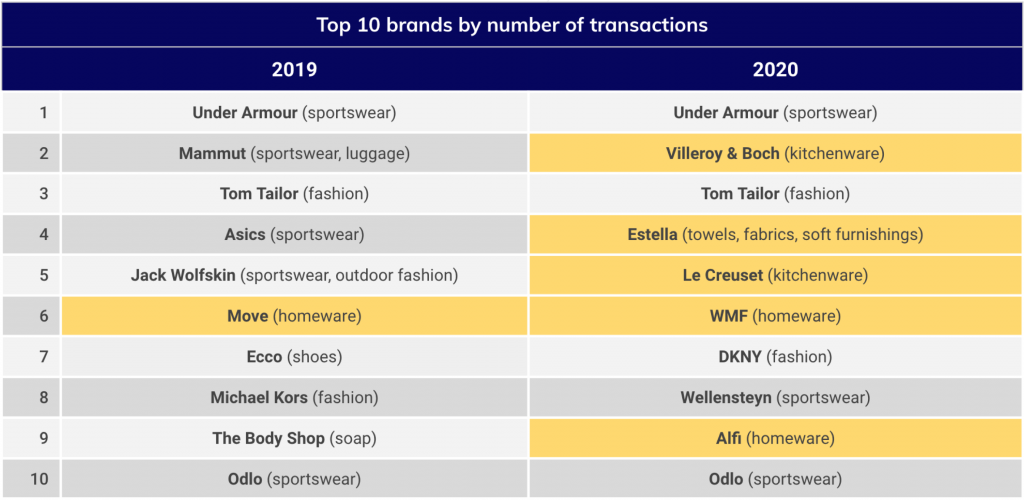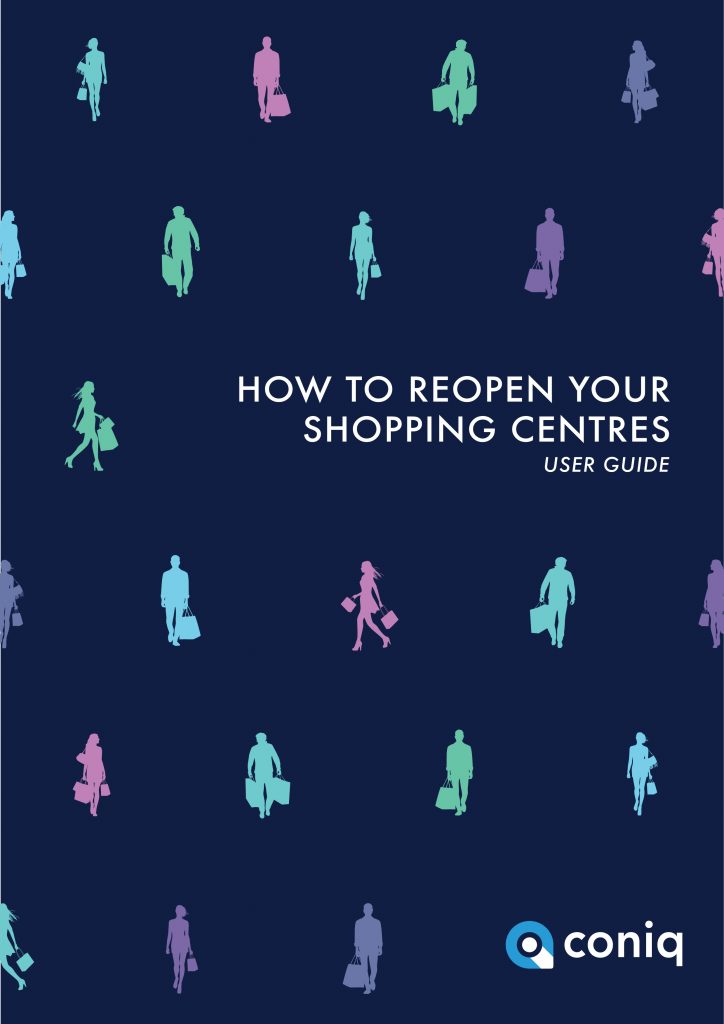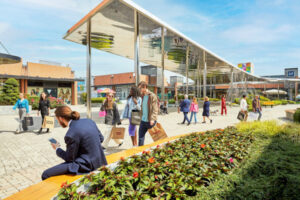THE FOUR MAIN TAKEAWAYS
- Post-COVID shoppers are attracted by a different retail mix, wth a focus on homeware and well-being brands and products.
- Within these shoppers, there are four main segments emerging from the COVID situation. How you attract and communicate to these segments will impact how well you bounce back so initially try to identify the “Hibernate and Spend” group.
- As your centres reopen and these shoppers come back, there will be four main phases detailed on the Coniq Re covery Wave. Building a deep understanding of who comes back in the “First Shoppers phase” will lay the foundation for the recovery of your centres.
- You are drivers and not passengers on this journey. You will need to measure and react much more quickly than you have in the past to deliver the right marketing messages to the right people at the right time.
MOVE QUICKLY
How managers, including heads of marketing, retail, leasing and operations, collaboratively respond to these uncharted times will define the pace of business recovery – and, for a number of companies, survivability.
Though there is much talk about a “new normal” post lock- down, there is little direction from the industry on what shopping malls and outlets should do to drive sales leading up to and after your destinations reopen. To help you, we have developed a framework to use when developing a plan of action to successfully engage customers.
CONSUMERS SEEK WELLBEING AND HOMEWARE BRANDS
During the recent lockdown, people changed how they shopped. The diagram below shows what consumers spent money on in centres that opened in Europe and the Middle East between April 25 and May 5, 2020.
It’s amazing to see how quickly the feelings of shoppers show themselves in the sales numbers from Coniq’s IQ platform. This time last year, there was just one homeware brand in the top 10. One year later, there are now five. Shopping centres must look at the brand mix as well as making sure that these brands are open to shoppers.
NEW CONSUMER SEGMENTS ARE EMERGING
There are four main shopper types emerging, according to research of 4,800 UK consumers by EY in April 2020; and each one needs to be treated differently in order to capi- talise on pent-up consumer demand to shop again in re- tail destinations:
“Cut deep” makes up 27% of consumers. These are the people hardest hit by the pandemic, and the most pessi- mistic about the future. “Cut deep” will shop only for es- sential items so they will likely be the last segment to come back to your centre and spend, and only after they know they can afford it.
“Save and stockpile” consists of 35% of consumers. These people are not so concerned about the pandemic but they are worried about their families. “Save and stockpile” will want to hear how you can help their family members get through this challenging time. This is a huge opportunity to build loyalty by being there for them.
“Stay calm, carry on” makes up 26% of consumers. These people are not changing their spending habits too much, and don’t feel directly impacted by the pandemic. That said, they are worried that others may stockpile, which means they will be watching what others are doing and buying. “Stay calm and carry on” are important because they have and will continue to spend money so identifica- tion is key.
“Hibernate and spend” consists of 11% of consumers. These are the most concerned about the pandemic. Yet, they are also best positioned to deal with it, financially as well as mentally. “Hibernate and spend” are optimistic about the future so focus much of your initial marketing ef- forts on them. They will be the first in your centre, and will fuel your bounceback in the short and mid-term.
EY’s four consumer segments capture how shoppers are behaving during the lockdown, so will not become long term segments – but they are very important to understand as you reopen your centres. The people shopping in the first weeks and months will not be the same shopper pro- files as you are used to seeing, so market and communi- cate accordingly.
CONIQ’S RECOVERY WAVE
The Coronavirus started to impact retail in early February when sales began to fall. However, it wasn’t until the middle of March that the dire consequences hit shopping cen- tres and retail shops.
The Coniq Recovery Wave, with its purple line, models the fall and recovery of sales over the course of the next nine months. We have outlined four core phases during this time, which reflect the type of engagement and action required on your part: first (crisis management), second (reopening), third (first shoppers) and fourth (business recovery).
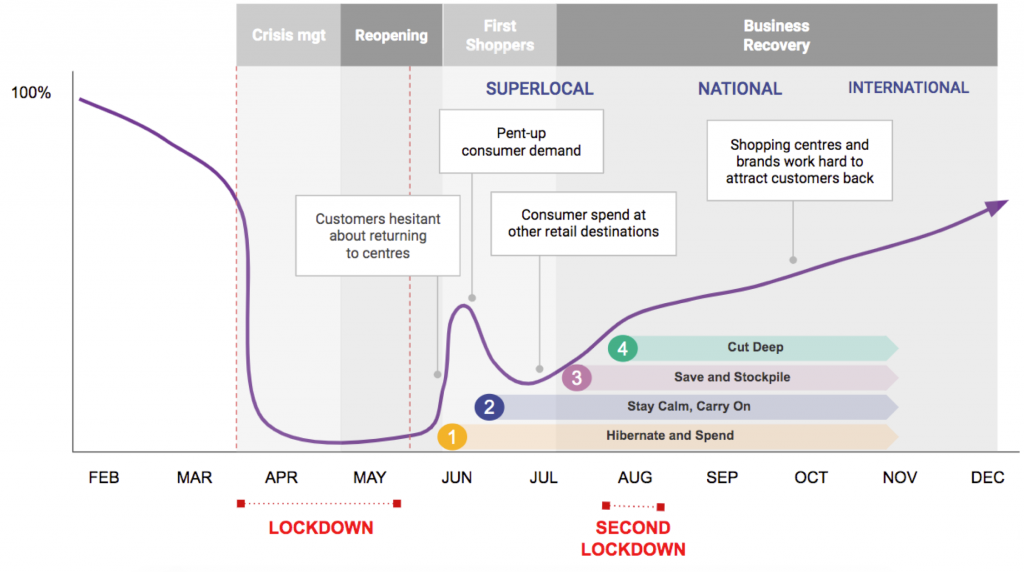
We have also overlaid on top of the wave the consumer seg- ments you will need to identify and engage, based on the research from EY, starting with “Hibernate and Spend” cus- tomers – those likely to return first to your centre. Simulta- neously, you should interact with other identified customer segments to fuel your business recovery later in the year.
It’s important to acknowledge that most of your custom- ers will come from your local community, so this should be a primary focus of your marketing efforts. As the public gains confidence in travelling, visitors to your centres will eventually expand to include people from farther afield, eventually from other countries.
This recovery wave is a framework to plan your customer engagement strategy, reflective of the need to actively em- brace change in how you interact with and attract shop- pers to your retail destination.
PRACTICAL STEPS TO ACCELERATE BUSINESS RECOVERY
How you respond and interact with your customers during and immediately after lockdowns will greatly influence the pace of business recovery. This is particularly true if there are lockdowns in the future because of the spread of the Coronavirus.
To help you focus your budgets and resources, we have pro- vided a framework of activities mapped to each phase in the Coniq Recovery Wave, taking into consideration the needs and wants of shoppers.
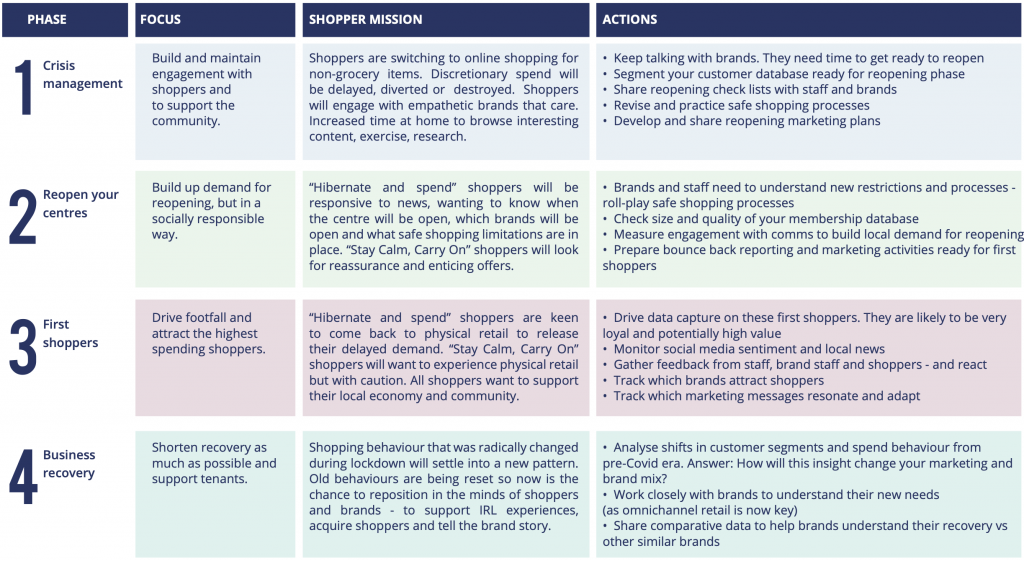
ACT SHORT-TERM, THINK LONG-TERM
The speed in which shopping centres successfully bounce back from current and future lockdowns will be based on how executives adapt to changes in consumer attitudes and behaviours.
From what we have seen already, business leaders have embraced this unprecedented challenge as an opportunity to improve their organisations. They have thought more about the future, asking themselves if the time has arrived to offer e-commerce to customers in addition to creating an enticing and entertaining retail destination to attract shoppers.
This user guide offers tips to help you capitalise on the short-term consumer demand to shop again in malls and outlets. Many of the ideas presented in the recovery wave will also enable you to establish an efficient customer engagement program to weather business disruptions and change in the long-term.
You can download the user guide here:
ABOUT CONIQ
Coniq is the Total Customer Engagement Company for growth minded shopping malls, outlets and retail brands seeking a faster, cheaper and simpler way to generate revenue by understanding, anticipating and engaging customers in real-time across multiple channels from a single platform, Coniq IQ. The Coniq platform powers over £1 billion of sales annually for its customers, with more than 20 million consumers shopping at more than 1,800 brands in 24 countries worldwide.
More infos: https://www.coniq.com
